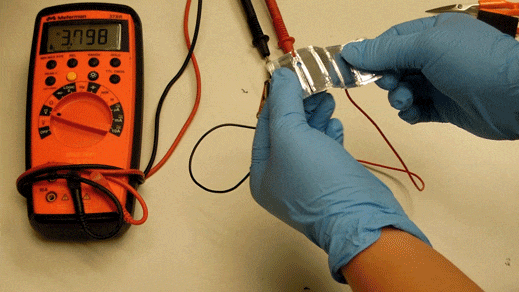A Stretchable, Bendable, and More Powerful Smart-Watch Battery
Smart watches may soon be able to run longer thanks to stretchable, bendable batteries.

Using a form of the Japanese folding technique origami, researchers have shown they can make conventionally manufactured lithium-ion batteries stretch and bend enough to fit inside a watchband, where there is more room to store energy. Besides boosting smart watches, the method, which the inventors say is compatible with standard manufacturing processes, could create batteries that are better fits for all sorts of other wearable electronic gadgets, like fitness bands that track health-related data (see “What Are the Prospects for Flexible Biosensors?”).
Today’s smart-watch batteries sit behind the screen, sharing the small space with all the other electronics that run the watch. Not only does the battery take up a large portion of the available space, but it has a relatively small energy capacity—an obstacle to smart-watch development, says Hanqing Jiang, a professor of mechanical and aerospace engineering at Arizona State University, who led the research on bendable batteries. Today’s watches don’t run very long: for example, the new Apple watch is said to last only a few hours if it is being “actively” used to run applications. The new technique could help double the batteries’ energy capacity, Jiang says.
The researchers used their folded battery to power a Samsung smart watch and showed that an elastic band with the battery inside can bend and stretch without affecting battery performance.
Over the past decade researchers have made a lot of progress designing stretchable electronics that can conform to curved and dynamic surfaces and shapes, like those of the human body, without malfunctioning. However, most have involved using elastic materials (see “A Battery That Stretches to Three Times Its Size”) and are not directly compatible with existing battery manufacturing facilities.
Jiang got the inspiration to apply origami to the problem when he noticed that a particular folding pattern, called Miura folding, closely resembled a pattern he’d seen before in nanoscale silicon, which allowed it to “buckle” and stretch when attached to the surface of an elastic rubber material (see “Sheets of Stretchable Silicon”). Last year, he and his colleagues demonstrated foldable lithium-ion batteries based on Miura folding. But the practical applications of that design are limited because the battery can only stretch from its folded state to its unfolded, flat state, and the folded form has uneven surfaces that make it unsuitable for something like a watchband, he says.
To create a more compatible form factor, the group decided to use kirigami, a variation of origami that entails cutting in addition to folding. Jiang and his colleagues have now demonstrated that by making widthwise cuts along the various material layers before laminating them together and then twisting or folding the structure in prescribed ways, they can make batteries that stretch. The stretching results from rotation that occurs at the cuts, and the device maintains a constant thickness when stretched, unlike the previous origami-based designs.
In addition to demonstrating the battery in a real smart watch, the researchers tested the compact and stretched forms to confirm that it retains its electrochemical and mechanical characteristics after many cycles, and they showed that the rotation during stretching does not cause the structure to fracture. Jiang says his group’s goal is to commercialize the technology, and it is now refining the battery packaging to address certain safety-related issues. He also says the kirigami technique is applicable to other types of electronic devices besides batteries, like sensors and supercapacitors.
Keep Reading
Most Popular
Large language models can do jaw-dropping things. But nobody knows exactly why.
And that's a problem. Figuring it out is one of the biggest scientific puzzles of our time and a crucial step towards controlling more powerful future models.
The problem with plug-in hybrids? Their drivers.
Plug-in hybrids are often sold as a transition to EVs, but new data from Europe shows we’re still underestimating the emissions they produce.
Google DeepMind’s new generative model makes Super Mario–like games from scratch
Genie learns how to control games by watching hours and hours of video. It could help train next-gen robots too.
How scientists traced a mysterious covid case back to six toilets
When wastewater surveillance turns into a hunt for a single infected individual, the ethics get tricky.
Stay connected
Get the latest updates from
MIT Technology Review
Discover special offers, top stories, upcoming events, and more.